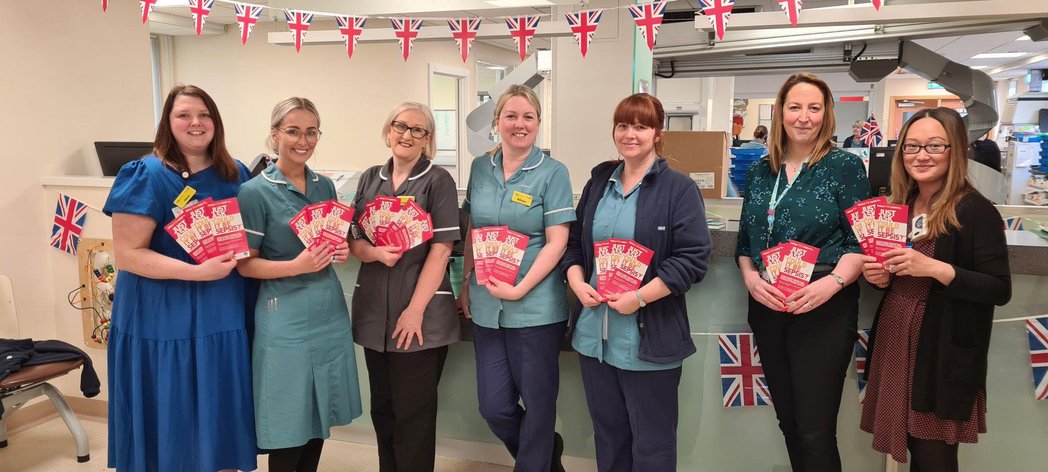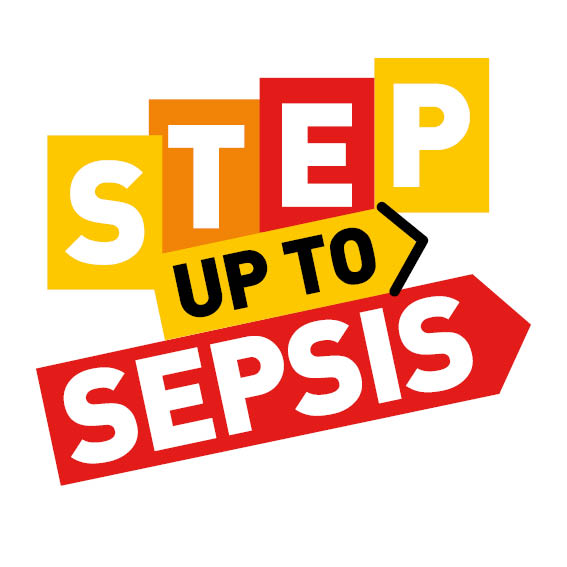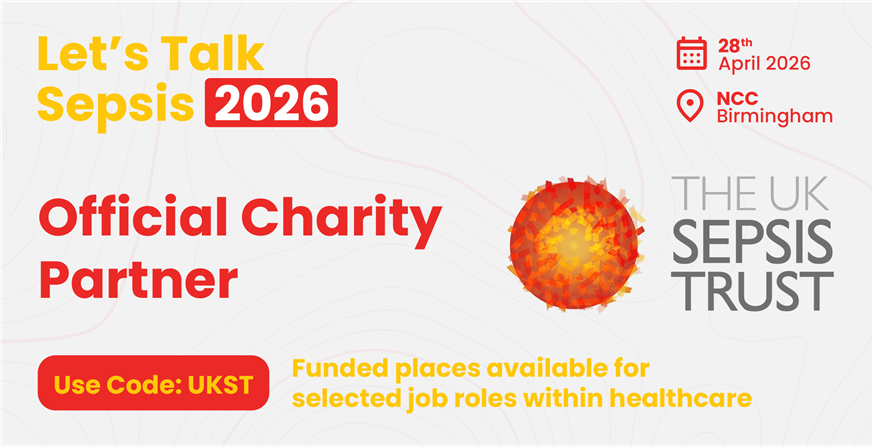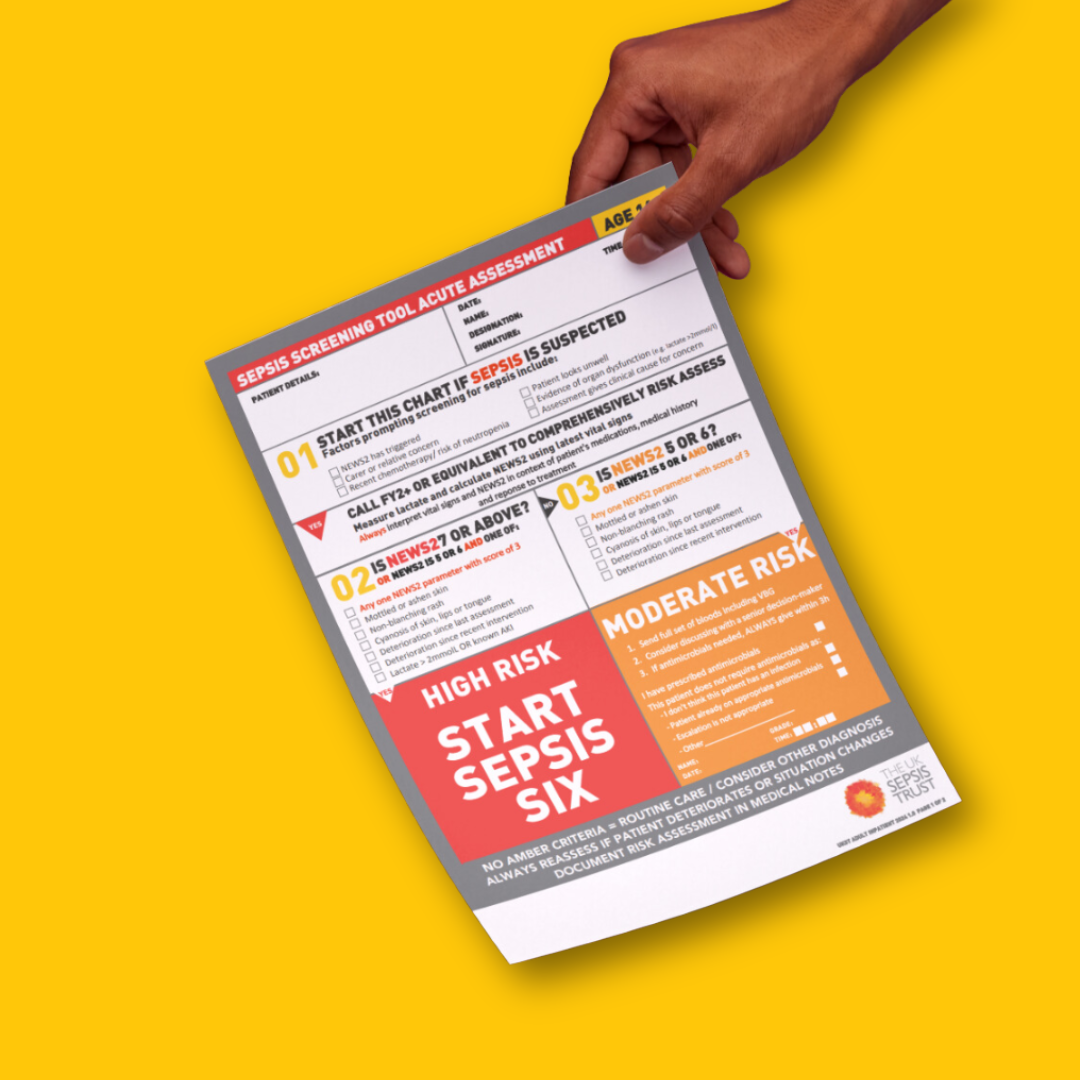Healthcare Hub
This dedicated page provides health professionals with free clinical tools, access to our e-learning materials and patient signposting information.
Working together to improve sepsis outcomes
The UK Sepsis Trust knows that to end preventable sepsis deaths, we need healthcare professionals that are primed to recognise and treat sepsis promptly, as well as an empowered public who know to Just Ask: Could it be sepsis?
On this page you can access the latest resources designed to support your efforts in sepsis management and patient care. Together, we can improve outcomes and offer compassionate support to those affected by sepsis.

Clinical tools
Education resources
CPD-accredited e-learning
Clinical tools & resources
In November 2025 NICE split its sepsis guidelines into three separate guidelines covering people aged 16 and over (NG253), children and young people (NG254) and those who are pregnant or have recently been pregnant (NG255).
Updated in 2025 and designed by our panel of expert clinicians in consultation with NICE, our new suite of clinical tools reflects the latest updates to NG253 (Nov 2025) and can now be implemented into clinical practice across the spectrum of healthcare. They aim to provide the optimum balance between saving lives from sepsis and a responsible approach to antimicrobial stewardship. UKST also supports NICE’s quality standard on suspected sepsis in over 16s.
We recommend you sign up for updates, so that we can let you know when the tools are updated. You can just download the tools, but in that case, we recommend you regularly revisit our site to check if there have been any changes.
Sepsis killed 288 yesterday. Together we can change this. UKST is on a mission to end preventable sepsis deaths – but we need your help.
Take part in Step Up To Sepsis
Sepsis currently claims 5 lives an hour in the UK, that’s 120 people every day, 48,000 annually – and our charity’s on a mission to change that!
If you’re looking for a fun team-building exercise that encourages healthy competition then look no further than our Step Up To Sepsis fundraising challenge. By taking part, you’ll be raising vital funds that will enable our work to continue, while also raising awareness of this life-threatening condition. Together, we can save thousands of lives.


Support for patients
If you are a healthcare professional supporting a patient through sepsis recovery, or helping a family in the wake of a sepsis bereavement then we have a range of services that you can signpost them to, including free support groups hosted by our trained Support Nurses.
Clinical FAQs
Who are the clinical experts at UKST?
UKST was founded in 2012 by Dr Ron Daniels, a practicing NHS intensive care consultant in Birmingham, after he witnessed the tragic and preventable death of Jem Abbotts.
Ron continues to work as one of the charity’s two Joint CEOs, and his clinical inputs are supported by Dr Tim Nutbeam.
Our clinical and patient-facing resources are also developed in consultation with our team of trained Support Nurses, including Lead Support Nurse Oliver Jones, who has an intensive care background.
While not a medical professional, UKST Ambassador Melissa Mead knows firsthand the devastating effects of sepsis. She works with healthcare providers and UKST to improve clinical outcomes after the tragic and preventable death of her one year old son, William, to sepsis.
What is the Sepsis Six?
UKST developed the Sepsis Six in 2005 as a practical tool to help healthcare professionals deliver the basics of care rapidly and reliably. It consists of six actions that should be actioned immediately when sepsis is suspected:
- Give the patient oxygen
- Give intravenous antibiotics
- Take blood cultures to identify the source of the underlying infection
- Give intravenous fluids
- Check lactate levels
- Monitor urine output
It has been endorsed by NICE and is used in 96% of British hospitals and in 37 other countries worldwide.
It was drawn from the international guidelines developed by the ‘Surviving Sepsis’ Campaign, but we recognised that a 16 page document containing 58 individual guidelines was unlikely to transform practice.
In 2011, we published evidence showing it to be associated with a 50% reduction in mortality – findings which others have since replicated.
What is Red Flag sepsis?
Red Flag Sepsis was developed by the UK Sepsis Trust in 2015. It is a practical, operational tool that empowers frontline health professionals to act without the need to apply the complex formal international definition of sepsis.
Based on the National Early Warning Score (NEWS), together with other parameters known to represent high risk in patients with sepsis, Red Flag Sepsis has since been supported by The National Institute for Health and Care Excellence (NICE).
We recommend that any patient who looks unwell, or who is triggering on the NEWS-2 score (Royal College of Physicians 2018), is screened for sepsis. If there is clinical suspicion of infection, then the presence of one or more Red Flags should be evaluated. If a Red Flag is identified, the Sepsis Six pathway should be started immediately.
Can I customise your toolkits?
Yes, the downloadable PDF toolkits allow you to make small amends such as adding your trust’s logo.
If you wish to discuss further modifications, please get in touch via email: info@sepsistrust.org
What is Post Sepsis Syndrome?
Around 40% of people who develop sepsis are estimated to suffer physical, cognitive, and/or psychological after effects.
For most people, these effects will only last a few weeks, but others can face a long road to recovery and develop Post Sepsis Syndrome (PSS). Post Sepsis Syndrome (PSS) describes a variable set of ongoing issues that people encounter for a prolonged period of time following sepsis.
PSS management by healthcare professionals typically involves addressing the specific symptoms experienced by the individual, and may include physical rehabilitation, cognitive rehabilitation, psychological counselling, and supportive care to help improve the patient’s overall wellbeing.
Learn more
My agency doesn’t have a sepsis pathway or uses an outdated one – what should I do?
With multiple agencies, including the World Health Organisation, recognising that the rapid identification and management of sepsis is a public health priority, every healthcare provider organisation should have a policy and/or pathway on sepsis.
If yours doesn’t have one, or uses an outdated version, why not lead its implementation or development? Identify the right people to speak to – typically safety or governance leads, or clinical champions.Organise a meeting, download the relevant tool for your clinical area from our tools page, and off you go. If you come up against barriers, get in touch. We might be able to help.
Should we be using the sepsis-3 definition?
There are three good things about the sepsis-3 definition:
- The narrative: that sepsis is a life-threatening condition arising when the body’s dysregulated response to infection causes organ dysfunction. This has removed the old ambiguity about describing patients with some systemic signs, but who were relatively well, as having ‘sepsis’.
- The new ‘official’ definition of organ dysfunction, using a change in SOFA (Sepsis-associated Organ Failure Assessment Score).
- Dropping SIRS (the Systemic Inflammatory Response Syndrome) from the definition of sepsis – SIRS was over-sensitive and poorly specific.
So yes, use the narrative* and let’s not use SIRS to diagnose sepsis!
If you’re a researcher, a change in SOFA score is the most appropriate way to ensure you’re recruiting the right patients. But at the bedside, we need something simpler – we use Red Flag sepsis as an empowering surrogate.
I’ve heard of qSOFA. Why isn’t UKST recommending we use that?
There is nothing wrong with qSOFA, the ‘bedside’ test proposed by the International Consensus Definitions Task Force. It is based on some evidence, albeit via a retrospective analysis of a large dataset, but is not prospectively validated.
It’s important to note that the Task Force did NOT propose qSOFA as either a treatment prompt or as a diagnostic tool – it was an identifier of patients in whom to look for sepsis.
Because we already use NEWS in the UK, and because it has since been shown to be as useful as qSOFA, we feel we should stick with what we know. We didn’t want our healthcare assistants, nurses, midwives and doctors to be asked to measure general risk using one scoring system, and then sepsis risk with another using different thresholds!
If your organisation uses electronic observations, it’s perfectly appropriate for qSOFA to be added as a second tool to identify risk. If you can’t automate it, though, both we and NICE suggest you stick with NEWS.
What is UKST doing about antimicrobial resistance?
Sepsis is treated with antibiotics. But antibiotic resistance is a growing threat. UKST is an advocate for responsible antimicrobial stewardship, ensuring appropriate use of antibiotics are built into all its activities relating to sepsis training, diagnosis and treatment.


